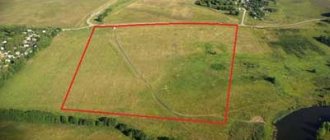Characteristics of the land plot
Individualization of a land plot as a real estate object is impossible without a description of its characteristics. The legislation does not contain an exhaustive list of land characteristics, however, an analysis of regulations makes it possible to classify the characteristics as follows:
- 1) Physical (technical);
- 2) Characteristics of the legal status of the land plot;
- 3) Economic;
- 4) Additional.
The characteristics of a land plot are used to describe it in the process of cadastral registration and entering information into the State Real Estate Cadastre. Data on the characteristics, the presence of which is a prerequisite for registering a plot of land and assigning it a unique cadastral number, is contained in the Federal Law of July 24, 2007 No. 221-FZ “On the State Real Estate Cadastre”, as well as in other by-laws.
Land is divided by category
1. Settlement lands are land occupied by settlements (cities, villages and villages) where people live.
Particularly valuable in this category of land are plots for individual housing construction (abbreviated as IHC).
On such plots it is possible to build a residential building on a permanent foundation;
2. Agricultural land
- This is land taken outside of populated areas.
But in some cases it has the right to build a house on it, with the possibility of registration in the constructed house at the place of residence.
And also, these are fields for planting fruit crops and cereals, animal pastures, meadows for mowing grass and civil cutting for SNT, DNP and other dacha associations.
Simply put, for dacha cooperatives, fenced with a common fence and having many small plots of land on their territory. With cuttings of several hundred square meters.
Belonging to different owners based on garden books or ownership documents.
This also includes gardens and vegetable gardens for planting horticultural crops for personal consumption by citizens.
Plots in the lands of this category for peasant farms (abbreviated as peasant farms) and for personal subsidiary plots (abbreviated for personal subsidiary plots) are especially valued.
3. Land of industry
- This is the land under enterprises and factories, highways for traffic, pipelines and poles with power lines.
Typically, a security zone (or buffer zone) is formed around areas with this purpose, with a ban on all types of construction.
This is done for the safe neighborhood or residence of people near air-polluting factories or highways with exhaust gases from cars moving along them.
Power poles also emit harmful electromagnetic radiation into the atmosphere, causing illness in humans with prolonged exposure.
4. Lands of specially protected territories and objects
, these are lands the owner of which can only be the state or the administration of the settlement.
To which these lands belong by territoriality.
These are mainly the banks of reservoirs or plots of land suitable for various types of tourism.
Particularly valuable areas located on these lands are nature reserves.
5. Forest lands
, these are lands occupied by the forest itself and forestry.
The sale of ownership of such plots is prohibited by law.
But their long-term lease from the settlement administration is possible. These lands are protected by the Forest Code of the Russian Federation.
6. Lands of the water fund
— these include the water bodies themselves and their protection zones.
As well as water intake zones and hydraulic structures.
7. Reserve lands -
These include lands for which their intended purpose has not yet been established.
Or such lands will soon be transferred to any other category of land as prescribed by the district administration.
Unique characteristics of the land plot
The bulk of information about the quantitative and qualitative properties of the site is contained in the physical (technical) characteristics. The mandatory elements of physical characteristics are:
- 1) Location of the plot of land. By the location of a site, the legislation understands the coordinates of the characteristic points of its boundaries, that is, the points of change in the description of the boundaries of the site and dividing them into parts (clause 7 of Article 38 of the Federal Law of July 24, 2007 No. 221-FZ “On the State Real Estate Cadastre”). With regard to certain parts of the boundaries, regulations may provide for a different procedure for determining their location: by indicating natural or artificially constructed objects, information about which is available in the State Real Estate Cadastre and whose boundaries coincide with the external boundaries of the site.
- 2) The area and dimensions of the land. The Federal Law “On the State Real Estate Cadastre” determines that the most important characteristics of land plots are the location of the borders and its area. When establishing the boundaries of a plot, the area of the plot is determined, which makes it possible to individualize a specific plot as an independent piece of real estate. The standard and actual area of the land plot is distinguished. For cadastral registration purposes, only the standard area of the land plot is used.
- 3) Address/Metro landmarks of the site. The assignment of an address occurs after the site is registered in the cadastral register.
- 4) Topographical and qualitative properties of the site. Includes a description of the surface and subsoil layers of the earth, landscape, contours and other topographic data.
Characteristics of the legal status of land consists of the following elements:
- 1) Information about the legal owners of the land plot. This information is contained in title documents certifying a certain type of land use. Such documents include a certificate of registration of rights, contracts, decisions on the provision of land, etc.).
- 2) Information about the category of land, intended purpose and permitted types of use of the land. The category and intended purpose of land is determined at the stage of cadastral registration. The types of permitted use of a land plot are determined by the copyright holder independently based on the category of land to which the plot belongs.
- 3) Type and form of right to a land plot. Since land plots are real estate objects, they can belong to a person under any proprietary right provided for by law (right of ownership, fixed-term use, etc.).
- 4) The presence of restrictions, encumbrances and easements in relation to the site. These types of restrictions on rights are established by a decision of authorized bodies or by agreement of the parties to the transaction.
The economic characteristics of the land plot include the following elements:
- 1) Cadastral value of land. This mandatory indicator is calculated during cadastral work and is used for tax purposes. Changing the cadastral value is permitted in court.
- 2) Market value of land. It is not a mandatory indicator, it is determined as the need arises by interested parties. Used to determine the price of a proposed land transaction.
Additional characteristics of the land plot are not mandatory, and their list may increase or decrease depending on the content of the legal relationship. The most important such characteristics are:
- 1) Environmental situation at the location of the land plot. It is essential in cases of acquisition of land by citizens for personal use, residence, etc.
- 2) Logistics (transport) indicators. Allows you to determine the availability of a land plot for transport infrastructure. It is important information for land plots used both in economic turnover and for personal use.
- 3) Geological indicators. In a number of regions, the data of this indicator make it possible to determine the seismicity of the site's location, which directly affects the future purpose of use for construction.
- 4) Other indicators. Interested parties and rights holders of land plots have the right to identify and establish other characteristics that are important for determining its properties.
The concept of land rights
The Land Code, one way or another, mentions a whole list of land rights or opportunities transferred to citizens, within the boundaries of which they have the right to use the existing territory. Some of them exist thanks to previously issued regulations that are no longer in effect. The right always remains in effect, and the citizen has the right to dispose of it at his own discretion, and they are also protected by law. The following types of rights are distinguished:
- unlimited free use;
- free use for a certain period of time;
- right of lifelong inheritable ownership;
- easements - the legal use of someone else's property;
- ownership;
- lease right.
With the exception of the last two, these forms of land rights are not mentioned in any other acts other than those related to land legislation.
Determination of the main characteristics of the land plot
Mandatory characteristics of a land plot are determined during cadastral work. Cadastral work consists of carrying out specific actions aimed at describing and individualizing land plots, accompanied by assigning to each plot special, unique characteristics that distinguish it from other territories and lands.
The result of the cadastral work is:
- 1) Preparation of a boundary plan for the site, which includes both a topographical image on a schematic map and a detailed description of the physical (technical) characteristics.
- 2) Carrying out cadastral registration, during which the mandatory characteristics of the site are entered into the State Real Estate Cadastre.
- 3) Assignment of a unique cadastral number.
Land valuation: definition and legislation
During the assessment of a land plot, subjects of assessment activities must rely on the norms of Federal Law-135 of 1998, as well as various standards of assessment activities (in particular, FSO 1,2,3,7 ) approved by orders of the Ministry of Economic Development.
The assessment of land plots should take into account the requirements of local regulations depending on the purposes of the analysis: obtaining a mortgage loan (legislation in the field of bank lending), concluding a purchase and sale agreement (civil law), etc.
How to find out the characteristics of a land plot?
A unique cadastral number assigned to a land plot allows you to obtain information about the main characteristics of the land plot. This can be done in two ways:
- 1) By obtaining a cadastral extract from the Rosreestr authorities. To receive an extract in electronic or written form, the interested person contacts the territorial body of Rosreestr indicating the cadastral number of the plot of interest;
- 2) By obtaining open data from the public cadastral map of Rosreestr, available at https://pkk5.rosreestr.ru/
Pitfalls when purchasing land plots
In order not to buy such a plot of land, you need to be able to understand the plans of the area.
Or be an advanced PC user, up to the level of working with an online cadastral map. Which, by the way, is also available on our website.
But this is only the first of several factors of your protection.
The second factor of protection against concluding a suspicious transaction for the purchase of an illiquid plot of land.
There will be your personal visit to the site and inspection of the site on the ground.
This is how you can be sure you're not buying a piece of rock or the side of a gutter.
The third factor of protection will be receiving a fresh extract from the Unified State Register of Real Estate for the land plot.
It is advisable to receive the statement directly on the day of the transaction or the day before.
From the extract it will be clear whether there are any encumbrances on the property in the form of collateral, mortgages or legal claims from third parties.
Or perhaps a long-term lease agreement has been registered on the site with an organization planning to place a power line pole or communications tower there. Imagine this also happens.
Or the land plot you are buying, due to its location, completely blocks access to several neighboring plots.
Who, by going to court, were able to impose a compulsory easement on the land you were buying.
Which gives your neighbors the right to freely drive and walk on your future land as many times as they please.
Changing the characteristics of a land plot
Changes in the characteristics of a site occur as a result of cadastral work and subsequent cadastral registration. The most common cases of changing characteristics are clarification of the boundaries and area of a land plot, the category and type of permitted land use.
Challenging established characteristics occurs in court and is most often used in cases of clarifying the boundaries of adjacent plots and changing the cadastral value of land. The decision of the judicial authority, which changes the characteristics of the site, is binding and is implemented by making changes to the cadastral registration information.
Author of the article
The relationship between the concepts of “land” and “land plot”
If a specific piece of land is not individualized, the concept of “land” is traditionally used. The concept of “land” is also used in relation to the lands that make up the fund of natural resources. And if legal relations arise regarding a certain plot indicating its characteristics (boundaries, area, etc.), the concept of “land plot” should be used.
Despite the fact that, according to Article 6 of the Land Code of the Russian Federation, both land and a land plot are objects of land relations, only a land plot can be the object of ownership rights.
Thus, the concepts of “land” and “land plot” are not recognized as identical; the term “land” is broader than the concept of “land plot”, which was noted, for example, in the ruling of the Supreme Court of the Russian Federation dated June 25, 2008 N 67-G08-5.



